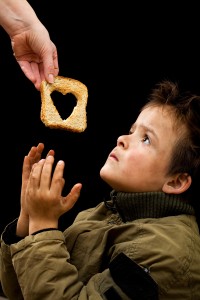
Arpad Nagy-Bagoly / Dollar Photo Club
In a perfect world, all children would have access to the foods they need to grow strong and healthy. In reality, though, food insecurity of all too common.
The definition of food insecurity from the USDA is “limited or uncertain availability of nutritionally adequate and safe foods or limited or uncertain ability to acquire acceptable foods in socially acceptable ways.”
In other words, short of stealing food, those experiencing food insecurity really do not know when the next meal is coming. In 2013, in the US alone, 8.6 million children experienced food insecurity. This is out of 73.6 million children (2013 stats). Almost 12%.
Luckily, our hunter-gatherer genes were designed for incredible hardships of starvation. But here’s the difference, our hunter-gatherer ancestors, when they finally got food after starvation, it was high quality, unprocessed food. The reality of today’s times is, that when a starving child gets food, it may very well be chips, enriched wheat flour bread or a chunk of cheese. The starving body does not do well when fed these foods (quite frankly, even the non-starving body does not do well with these foods…).
So why do kids get these foods? Several bad reasons:
- It has been established that lower socioeconomic neighborhoods have more access to fast food restaurants as well as convenience stores, as opposed to grocery stores with fresh produce.
- The parents of these children may not understand that products made by major confectionary companies like Nabisco, Quaker and Kraft really do not make high-quality products.
- Probably the biggest offender is Federal subsidies that support low quality staple foods like corn and wheat rather than fresh fruits and vegetables.
This particular article really drives home just how bad the situation is. In it, researchers looked at 3605 fourth- and fifth-grade children whose schools participated in the Network for a Healthy California–Children’s PowerPlay! campaign. These children were asked to complete a 24 hour food diary as well as Child Food Security Assessment questions. Here’s what they found:
- Childhood food insecurity was present in 60% of the children.
- These experiences included cognitive, emotional, and physical awareness of food insecurity.
- Those kids who had higher food insecurity had a higher intake of calories, fat, sugar, and fiber and a diet lower in vegetables.
- These kids also 17 min/day less physical activity.
Pretty much a perfect storm of future health problems. We already know that childhood maltreatment may shorten lifespan and that it also greatly increases the risk that a child may suffer migraines later in life. Add to the list now that these children will likely be at greater risk of obesity, diabetes, heart disease and cancer.
I just spoke with a patient (adult) yesterday who was having food security problems. We had a discussion about her options, which included, here in Phoenix, Market on the Move, where you can get 60 lbs of produce for $10. Yup. $10. That would solve several families’ worth of food insecurity for a few weeks. Granted, this is only one local resource, but if you look hard enough most communities have resources for GOOD food available.
